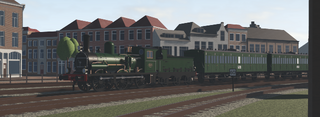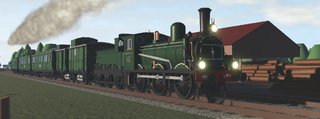 | |
| NS 3200 | |
|---|---|
| by Supersnel11 | |
| Price | ƒ55.000 |
| Level | 11 |
| Statistics | |
| Type | Mixed |
| Top Speed | 75 km/h |
| Weight | 73 tons |
| Capacity | 370 tons |
| Passenger Capacity | 1 first class 2 second class |
| Length | 15,5 meters |
The NS 3200 was a class of Dutch C (0-6-0) goods locomotives. 47 were built for the Hollandsche IJzeren Spoorweg-Maatschappij (HSM) between 1895 and 1907, at Sharp Stuart & Company and Werkspoor.
Variants
The NS 3200 is only available in Nederlandsche Spoorwegen green.
Historic details
The early years
After the good performance of the HSM 350-408 (later NS 1600) from Sharp Stuart, the HSM ordered similar locomotives to be used on goods trains. The first 16 locomotives were delivered between 1895 and 1898 and numbered HSM 601-616. They performed so well, that they were stationed at the four most important goods depots of the HSM. In 1900, the first locomotives of an additional batch, made by Werkspoor, came in. Werkspoor would continue to produce and deliver more of the HSM 600s until 1907, where the class had grown to a respectable 47 members. HSM 632 was the 100th locomotive Werkspoor produced.

The first job any new 600 was given was shunting at a HSM depot in Amsterdam. This period was seen as the 'running in' of these machines. After that they were either put on goods trains or stationed at one of the other three major goods depots. This remained unchanged until about 1910. In this period the 600s were used for international goods trains so much that they were stationed at nearly every HSM depot. The First World War caused some changes in the flow of goods, so the machines were stationed at Almelo, followed by Apeldoorn and Rotterdam Maas in 1914 and 1915. The HSM 613 and 647 were rented to the NCS in the first half of 1918. After 1919 they could also be found at Arnhem, Vlissingen, Feijenoord and Eindhoven. Notably, five were stationed at the Staatspoorwegen depot in Weert from September 1918 to August 1919.
In 1900, the HSM had an additional 31 built at Werkspoor, to the same design as the English-built locomotives. Some of the class ended up in Germany during World War II. They were withdrawn between 1936 and 1949, with none being preserved.
The later years
In the first years after the fusion of the HSM and the SS, the NS 3200s were still given the heavier work, but from different depots. Depot Feijenoord had about 25 of them at the end of the 1920s, but around 1934 they were mostly back the original HSM depot in Amsterdam with others spread around the Northern half the Netherlands. By now their workload had grown smaller and it would continue to do so until the end. They mostly pulled local goods trains or light passenger trains.
The first to be withdrawn were the NS 3215 and 3222 in 1936, the 3225 was withdrawn a year later. The NS 3202/08/14 and 3239 were withdrawn from service in 1938. The remaining 40 remained in service until the railway strike of 1944. Only ten would remain within the borders, of which only the 3234, 3245 and 3247 were operational. The seven that were not scrapped already, would be between 1945-1947. Of the 30 that were missing, only five (3207/12/13/19 & 3230) would not return and were administratively withdrawn in 1948. Only two of the 25 that returned (3226, found in Eldagsen, & 3231, found in Hagen) were restored. The others were sent off for scrap in 1947.
The 3245 and 3247 were formally withdrawn on December 31st, 1947, although the 3247 was still doing shunting jobs in Enschede the following year. The other three (3226, 3231 & 3234) were kept in service at Groningen depot until the end of 1949.
At some point in their careers, they earned the nickname "Wilde varkens" (wild pigs) from the drivers.
Technical details
The HSM 600 were originally equipped with: a Hardy-vacuum brake or Westinghouse brakes (automatic and independent; only the last four), connections for steam heating on the front and back of the tender, Stroudley-speedometers, spring-loaded safety valves, Ramsbottom security of the firebox and Gresham & Craven steam-powered sanders.
The cylinders, firebox and many small parts were identical to those of the HSM 350-408 and the HSM 701-755 (later NS 5500). A mechanical issue the HSM 600s had were axle bearings getting too hot, which caused a good chunk of the series to have regular visits to the works. According to lead engineer Hupkes, this happened because the piston rod was placed 180 degrees opposite of the coupling rod's crank pin.
The tenders of the 601-605 & 609-612 were delivered with extra large tenders, equal to those of the HSM 359-408. That was done so they could be swapped with those of the HSM 350-358, which still had their smaller NRS tenders.
The entire series, with the exception of the last four, was delivered with just a Hardy-vacuum brake. Nothing fancier was required because they were meant for goods trains only. The last four did have the Westinghouse brake, because they were also intended for passenger trains. The other locomotives had their Hardy brakes replaced with Westinghouse brakes with a compound air pump. In the 1930s, NS fitted their 3200s with an additional Henry brake.
The HSM 609 & 640 were fitted with Weir pre-heaters in 1916. The rest of the series got a Knorr pre-heater with a heating surface of 9,2 m² and a pump with a capacity of 120 litres a minute in 1917. Only in 1934 did the, now renumbered, NS 3209 and 3240 get its own Knorr pre-heater.
The NS 3232 was used to trial a superheater in 1922. However, this was unsuccessful because the higher temperature steam caused troubles with the lubrication of the slide valves, which increased the pace of deterioration. And yet, the 3232 kept its superheater.
The safety valve on top of the steam dome was made redundant in 1930. From that point onwards the series slowly had their old domes replaced with entirely enclosed ones.
A some of the series received an air powered bell for branchline services. All of them received a double regulator key for shunting jobs and the majority also got tender cabs.
Trivia
- The in-game model features a bell, which were only present on some of the members in the series, not all.
- The whistle sounds of the NS 3200 are from the British SECR C class, a similarly proportioned C class.
- In streamlined, there are more numbers available to use than that would of been in service in streamlined's time period.
- NS 3202, 3207, 3208, 3212-3215, 3219, 3222, 3225 and 3230 were either already scrapped before the war or did not return from being sent abroad during the war.
- In its later years, the NS 3200 had a wind protection addition built onto its tender which is seen in game.
- The NS 3200 was added in version 0.4.3.
Gallery
-
NS 3226 entering Dokmuiden station.
-
NS 3215 passing the logging camp on its way to Dokmuiden.
-
NS 3215 again, this time seen driving to its final destination at night.



